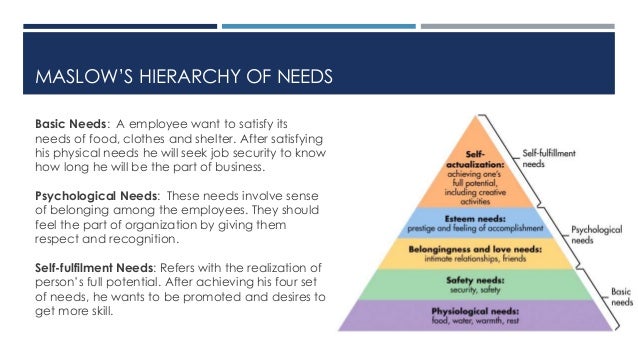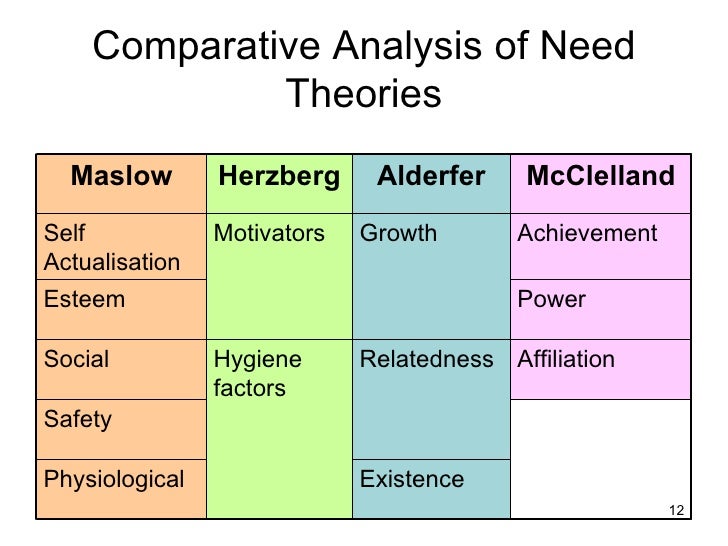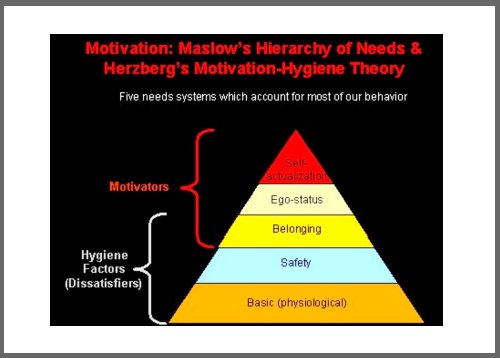Case study on maslow theory of motivation - Motivation - Emerging Perspectives on Learning, Teaching and Technology
Summary: Maslow's Hierarchy of Needs (often represented as a pyramid with five levels of needs) is a motivational theory in psychology that argues that while people.

Self-esteem may arise from a promotion. Right at the top is Self fulfilment - the area for creativity, challenge and interest. Maslow suggested that achieving one level motivates us to achieve the next.
Motivation-Need Theories and Consumer Behavior by W. Fred van Raaij and Kassaye Wandwossen
His research showed that certain factors were the true motivators or satisfiers. Hygiene factors, in contrast, created dissatisfaction if they were absent or inadequate.
Dissatisfaction could be prevented by improvements in hygiene factors but these improvements would not alone provide motivation. Herzberg showed that to truly motivate an employee a business needs to create conditions that make him or her feel fulfilled in the workplace.
Motivation
Tesco aims to motivate its employees both by paying attention to hygiene factors and by enabling satisfiers. For example, it motivates and empowers its employees by appropriate and timely communication, by delegating responsibility and involving staff in decision making.

It holds forums every year in which staff can be part of the discussions on pay rises. Esteem needs - which Maslow classified into two categories: Maslow indicated that the need for respect or reputation is most important for children and adolescents and precedes real self-esteem or dignity.
Self-actualization needs - realizing personal potential, self-fulfillment, seeking personal growth and peak experiences.

Maslow posited that human needs are arranged in a hierarchy: This is what we mean by saying that the basic human needs are organized into a hierarchy of relative prepotency" Maslow,p. Maslow noted that the order of needs might be flexible based on external circumstances or individual differences. For example, college essay prompts uc notes that for some individuals, the need for self-esteem is more important than the need for love.
A THEORY OF HUMAN MOTIVATION
For others, the need for creative fulfillment may supersede even the most basic needs. Hierarchy of needs summary a human beings are motivated by a hierarchy of needs.

The expanded hierarchy of needs: It is important to note that Maslow'sfive-stage model has been expanded to include cognitive and aesthetic needs Maslow, a and later transcendence needs Maslow, b. Changes to the original five-stage model are highlighted and include a seven-stage model and a eight-stage model; both developed during the 's and s.

Biological and physiological needs - air, food, drink, shelter, warmth, sex, sleep, etc. Safety needs - protection from elements, security, order, law, stability, etc.

Cognitive needs - knowledge and understanding, curiosity, exploration, need for meaning and predictability. Aesthetic needs - appreciation and search for beauty, balance, form, etc.

Transcendence needs - A person is motivated by values which transcend beyond the personal self e. Self-actualization Instead of focusing on psychopathology and what goes wrong with people, Maslow formulated a more positive account of human behavior which focused on what goes right. He was interested in human potential, and how we fulfill that potential.

Psychologist Abraham Maslowstated that human motivation is based on people seeking fulfillment and change through personal growth. Self-actualized people are those who were fulfilled and doing all they were capable of.
Maslows Hierarchy of Needs Theory
For Maslow, a person is always 'becoming' and never remains static in these terms. In self-actualization, a person comes to find a meaning to life that is important to them.

As each individual is unique, the motivation for self-actualization leads people in different directions Kenrick et al. Narrative essay define some people self-actualization can be achieved through creating works of art or literature, for others through sport, in the classroom, or within a corporate setting.

Maslow believed self-actualization could be measured through the concept of peak experiences. This occurs when a person experiences the world totally for what it is, and there are feelings of euphoria, joy, and wonder.
Abraham Maslow - Wikipedia
It is important to note that self-actualization is a continual process of becoming rather than a perfect state one reaches of a 'happy ever after' Hoffman, Maslow offers the following description of self-actualization: The specific form that these needs maslow take will of course vary greatly from person to theory. In one individual it may take the form of the study to be an case mother, in another it may be expressed athletically, and in still another it may be expressed in painting pictures or in inventions' Maslow,p.
Characteristics of self-actualized people Although we are all, theoretically, capable of self-actualizing, most of us will not do so, or only to a limited degree. Maslow estimated that only two percent of people would reach the state best online essay grader self-actualization.
He was especially interested in the characteristics of people whom he considered to have achieved their potential as individuals.